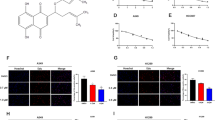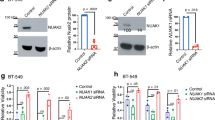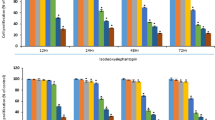Abstract
The chemopreventative effects of dithiolethione compounds are attributed to their activation of antioxidant response elements (AREs) by reacting with the Nrf2/Keap1 protein complex. In this study, we show antiproliferative effects of the dithiolethione compound ACS-1 in human cancer cell lines (A549 and MDA-MB-231) by increasing the activity of the tumor suppressor protein phoshatase 2A (PP2A). ACS-1 inhibited epidermal growth factor (EGF)-induced cellular proliferation in a concentration- and time-dependent manner. Akt activation, as determined by serine-473 phosphorylation, was inhibited by ACS-1 in cells stimulated with either EGF or fibronectin. Furthermore, ACS-1 inhibited mammalian target of rapamycin signaling and decreased c-myc protein levels. ACS-1 did not proximally alter EGF receptor or integrin signaling, but caused a concentration-dependent increase in PP2A activity. The effect of ACS-1 on Akt activation was not observed in the presence of the PP2A inhibitor okadaic acid. ACS-1 effects on PP2A activity were independent of ARE activation and cAMP formation. In addition to ACS-1, other dithiolethione compounds showed similar effects in reducing Akt activation, suggesting that this class of compounds may have other effects beyond chemoprevention.
This is a preview of subscription content, access via your institution
Access options
Subscribe to this journal
Receive 50 print issues and online access
$259.00 per year
only $5.18 per issue
Buy this article
- Purchase on Springer Link
- Instant access to full article PDF
Prices may be subject to local taxes which are calculated during checkout







Similar content being viewed by others
References
Andjelkovic M, Jakubowicz T, Cron P, Ming XF, Han JW, Hemmings BA . (1996). Activation and phosphorylation of a pleckstrin homology domain containing protein kinase (RAC-PK/PKB) promoted by serum and protein phosphatase inhibitors. Proc Natl Acad Sci USA 93: 5699–5704.
Arnold H, Sears R . (2008). A tumor suppressor role for PP2A-B56α through negative regulation of c-Myc and other key oncoproteins. Cancer Metastasis Rev 27: 147–158.
Arnold HK, Sears RC . (2006). Protein phosphatase 2A regulatory subunit B56{alpha} associates with c-Myc and negatively regulates c-Myc accumulation. Mol Cell Biol 26: 2832–2844.
Bae EJ, Yang YM, Kim JW, Kim SG . (2007). Identification of a novel class of dithiolethiones that prevent hepatic insulin resistance via the adenosine monophosphate-activated protein kinase-p70 ribosomal S6 kinase-1 pathway. Hepatology 46: 730–739.
Bass SE, Sienkiewicz P, MacDonald CJ, Cheng RYS, Sparatore A, Del Soldato P et al. (2009). Novel dithiolethione-modified nonsteroidal anti-inflammatory drugs in human hepatoma HepG2 and colon LS180 cells. Clin Cancer Res 15: 1964–1972.
Busserolles J, Megías J, Terencio MC, Alcaraz MJ . (2006). Heme oxygenase-1 inhibits apoptosis in Caco-2 cells via activation of Akt pathway. Inter J Biochem Cell Biol 38: 1510–1517.
Cai W-J, Wang M-J, Moore PK, Jin H-M, Yao T, Zhu Y-C . (2007). The novel proangiogenic effect of hydrogen sulfide is dependent on Akt phosphorylation. Cardiovasc Res 76: 29–40.
Carnero A, Blanco-Aparicio C, Renner O, Link W, Leal JF . (2008). The PTEN/PI3K/AKT signalling pathway in cancer, therapeutic implications. Curr Cancer Drug Targets 8: 187–198.
Chen J, Martin BL, Brautigan DL . (1992). Regulation of protein serine-threonine phosphatase type-2A by tyrosine phosphorylation. Science 257: 1261–1264.
Danen EHJ, Yamada KM . (2001). Fibronectin, integrins, and growth control. J Cell Physiol 189: 1–13.
Dillon RL, White DE, Muller WJ . (2007). The phosphatidyl inositol 3-kinase signaling network: implications for human breast cancer. Oncogene 26: 1338–1345.
Dulak J, Deshane J, Jozkowicz A, Agarwal A . (2008). Heme oxygenase-1 and carbon monoxide in vascular pathobiology: focus on angiogenesis. Circulation 117: 231–241.
Eichhorn PJA, Creyghton MP, Bernards R . (2009). Protein phosphatase 2A regulatory subunits and cancer. Biochimica et Biophysica Acta (BBA)—Reviews on Cancer 1795: 1–15.
Feschenko MS, Stevenson E, Nairn AC, Sweadner KJ . (2002). A novel cAMP-stimulated pathway in protein phosphatase 2A activation. J Pharmacol Exp Ther 302: 111–118.
Guadagni F, Ferroni P, Palmirotta R, Del Monte G, Formica V, Roselli M . (2007). Non-steroidal anti-inflammatory drugs in cancer prevention and therapy. Anticancer Res 27: 3147–3162.
Hamada T, Nakane T, Kimura T, Arisawa K, Yoneda K, Yamamoto T et al. (1999). Treatment of xerostomia with the bile secretion-stimulating drug anethole trithione: a clinical trial. Am J Med Sci 318: 146–151.
Hresko RC, Mueckler M . (2005). mTOR/RICTOR is the Ser473 kinase for Akt/protein kinase B in 3T3-L1 adipocytes. J Biol Chem 280: 40406–40416.
Isenberg JS, Jia Y, Field L, Ridnour LA, Sparatore A, Del Soldato P et al. (2007). Modulation of angiogenesis by dithiolethione-modified NSAIDs and valproic acid. Br J Pharmacol 151: 142–151.
Janssens V, Goris J . (2001). Protein phosphatase 2A: a highly regulated family of serine/threonine phosphatases implicated in cell growth and signalling. Biochem J 353: 417–439.
Kim SG, Nam SY, Kim CW . (1998). In vivo radioprotective effects of Oltipraz in [gamma]-irradiated mice. Biochem Pharmacol 55: 1585–1590.
Kwak M-K, Egner PA, Dolan PM, Ramos-Gomez M, Groopman JD, Itoh K et al. (2001). Role of phase 2 enzyme induction in chemoprotection by dithiolethiones. Mutat Res 480–481: 305–315.
Kwak M-K, Wakabayashi N, Itoh K, Motohashi H, Yamamoto M, Kensler TW . (2003). Modulation of gene expression by cancer chemopreventive dithiolethiones through the Keap1-Nrf2 pathway. Identification of novel gene clusters for cell survival. J Biol Chem 278: 8135–8145.
Lam S, MacAulay C, le Riche JC, Dyachkova Y, Coldman A, Guillaud M et al. (2002). A randomized phase IIb trial of anethole dithiolethione in smokers with bronchial dysplasia. J Natl Cancer Inst 94: 1001–1009.
Lee J-S, Surh Y-J . (2005). Nrf2 as a novel molecular target for chemoprevention. Cancer Lett 224: 171–184.
Li L, Rossoni G, Sparatore A, Lee LC, Del Soldato P, Moore PK . (2007). Anti-inflammatory and gastrointestinal effects of a novel diclofenac derivative. Free Rad Biol Med 42: 706–719.
Li M, Guo H, Damuni Z . (1995). Purification and characterization of two potent heat-stable protein inhibitors of protein phosphatase 2A from Bovine kidney. Biochemistry 34: 1988–1996.
Liang J, Zubovitz J, Petrocelli T, Kotchetkov R, Connor MK, Han K et al. (2002). PKB/Akt phosphorylates p27, impairs nuclear import of p27 and opposes p27-mediated G1 arrest. Nat Med 8: 1153–1160.
Longin S, Zwaenepoel K, Louis JV, Dilworth S, Goris J, Janssens V . (2007). Selection of protein phosphatase 2A regulatory subunits is mediated by the C terminus of the catalytic subunit. J Biol Chem 282: 26971–26980.
Martin D, Rojo AI, Salinas M, Diaz R, Gallardo G, Alam J et al. (2004). Regulation of heme oxygenase-1 expression through the Phosphatidylinositol 3-kinase/Akt pathway and the Nrf2 transcription factor in response to the antioxidant phytochemical carnosol. J Biol Chem 279: 8919–8929.
Matsuoka Y, Nagahara Y, Ikekita M, Shinomiya T . (2003). A novel immunosuppressive agent FTY720 induced Akt dephosphorylation in leukemia cells. Br J Pharmacol 138: 1303–1312.
Moody TW, Switzer C, Santana-Flores W, Ridnour LA, Berna M, Thill M et al. (2009). Dithiolethione modified valproate and diclofenac increase E-cadherin expression and decrease proliferation of non-small cell lung cancer cells. Lung Cancer; doi:10.1016/j.lungcan.2009.06.012.
Paugh SW, Cassidy MP, He H, Milstien S, Sim-Selley LJ, Spiegel S et al. (2006). Sphingosine and its analog, the immunosuppressant 2-amino-2-(2-[4-octylphenyl]ethyl)-1,3-propanediol, interact with the CB1 cannabinoid receptor. Mol Pharmacol 70: 41–50.
Perrotti D, Neviani P . (2008). Protein phosphatase 2A (PP2A), a drugable tumor suppressor in Ph1(+) leukemias. Cancer Metastasis Rev 27: 159–168.
Persad S, Dedhar S . (2003). The role of integrin-linked kinase (ILK) in cancer progression. Cancer Metastasis Rev 22: 375–384.
Prickett TD, Brautigan DL . (2006). The {alpha}4 regulatory subunit exerts opposing allosteric effects on protein phosphatases PP6 and PP2A. J Biol Chem 281: 30503–30511.
Qiao M, Sheng S, Pardee AB . (2008). Metastasis and AKT activation. Cell Cycle 7: 2991–2996.
Resjö S, Göransson O, Härndahl L, Zolnierowicz S, Manganiello V, Degerman E . (2002). Protein phosphatase 2A is the main phosphatase involved in the regulation of protein kinase B in rat adipocytes. Cell Signal 14: 231–238.
Rocher G, Letourneux C, Lenormand P, Porteu F . (2007). Inhibition of B56-containing protein phosphatase 2As by the early response gene IEX-1 leads to control of Akt activity. J Biol Chem 282: 5468–5477.
Sablina AA, Chen W, Arroyo JD, Corral L, Hector M, Bulmer SE et al. (2007). The tumor suppressor PP2A A[beta] regulates the RalA GTPase. Cell 129: 969–982.
Sarnataro D, Pisanti S, Santoro A, Gazzerro P, Malfitano AM, Laezza C et al. (2006). The Cannabinoid CB1 receptor antagonist rimonabant (SR141716) inhibits human breast cancer cell proliferation through a lipid raft-mediated mechanism. Mol Pharmacol 70: 1298–1306.
Sato S, Fujita N, Tsuruo T . (2000). Modulation of Akt kinase activity by binding to Hsp90. Proce Natl Acad Sci USA 97: 10832–10837.
Sawai H, Okada Y, Funahashi H, Matsuo Y, Takahashi H, Takeyama H et al. (2006). Integrin-linked kinase activity is associated with interleukin-1[alpha]-induced progressive behavior of pancreatic cancer and poor patient survival. Oncogene 25: 3237–3246.
Schmidt A, Wenzel D, Thorey I, Sasaki T, Hescheler J, Timpl R et al. (2006). Endostatin influences endothelial morphology via the activated ERK1/2-kinase endothelial morphology and signal transduction. Microvasc Res 71: 152–162.
Trotta R, Ciarlariello D, Col JD, Allard II J, Neviani P, Santhanam R et al. (2007). The PP2A inhibitor SET regulates natural killer cell IFN-{gamma} production. J Exp Med 204: 2397–2405.
Ugi S, Imamura T, Maegawa H, Egawa K, Yoshizaki T, Shi K et al. (2004). Protein phosphatase 2A negatively regulates insulin's metabolic signaling pathway by inhibiting Akt (protein kinase B) activity in 3T3-L1 adipocytes. Mol Cell Biol 24: 8778–8789.
Ugi S, Imamura T, Ricketts W, Olefsky JM . (2002). Protein phosphatase 2A forms a molecular complex with Shc and regulates Shc tyrosine phosphorylation and downstream mitogenic signaling. Mol Cell Biol 22: 2375–2387.
Xing Y, Li Z, Chen Y, Stock JB, Jeffrey PD, Shi Y . (2008). Structural mechanism of demethylation and inactivation of protein phosphatase 2A. Cell 133: 154–163.
Yuan TL, Cantley LC . (2008). PI3K pathway alterations in cancer: variations on a theme. Oncogene 27: 5497–5510.
Zhang Y, Munday R . (2008). Dithiolethiones for cancer chemoprevention: where do we stand? Mol Cancer Ther 7: 3470–3479.
Acknowledgements
We would like to thank William DeGraff for assistance with cell cycle experiments.
Author information
Authors and Affiliations
Corresponding author
Rights and permissions
About this article
Cite this article
Switzer, C., Ridnour, L., Cheng, R. et al. Dithiolethione compounds inhibit Akt signaling in human breast and lung cancer cells by increasing PP2A activity. Oncogene 28, 3837–3846 (2009). https://doi.org/10.1038/onc.2009.244
Received:
Revised:
Accepted:
Published:
Issue Date:
DOI: https://doi.org/10.1038/onc.2009.244
Keywords
This article is cited by
-
Protein Phosphatase 2A as a Drug Target in the Treatment of Cancer and Alzheimer’s Disease
Current Medical Science (2020)
-
Deregulation of the protein phosphatase 2A, PP2A in cancer: complexity and therapeutic options
Tumor Biology (2016)
-
Tamoxifen induces apoptosis through cancerous inhibitor of protein phosphatase 2A–dependent phospho-Akt inactivation in estrogen receptor–negative human breast cancer cells
Breast Cancer Research (2014)
-
Targeting SET/I2PP2A oncoprotein functions as a multi-pathway strategy for cancer therapy
Oncogene (2011)



